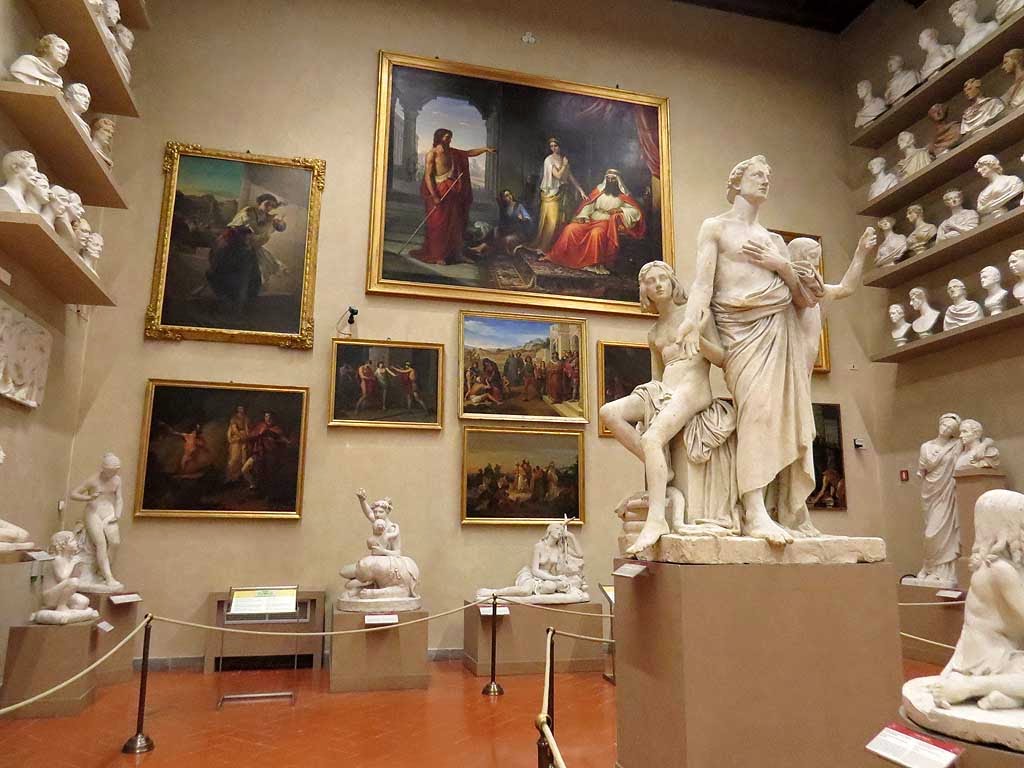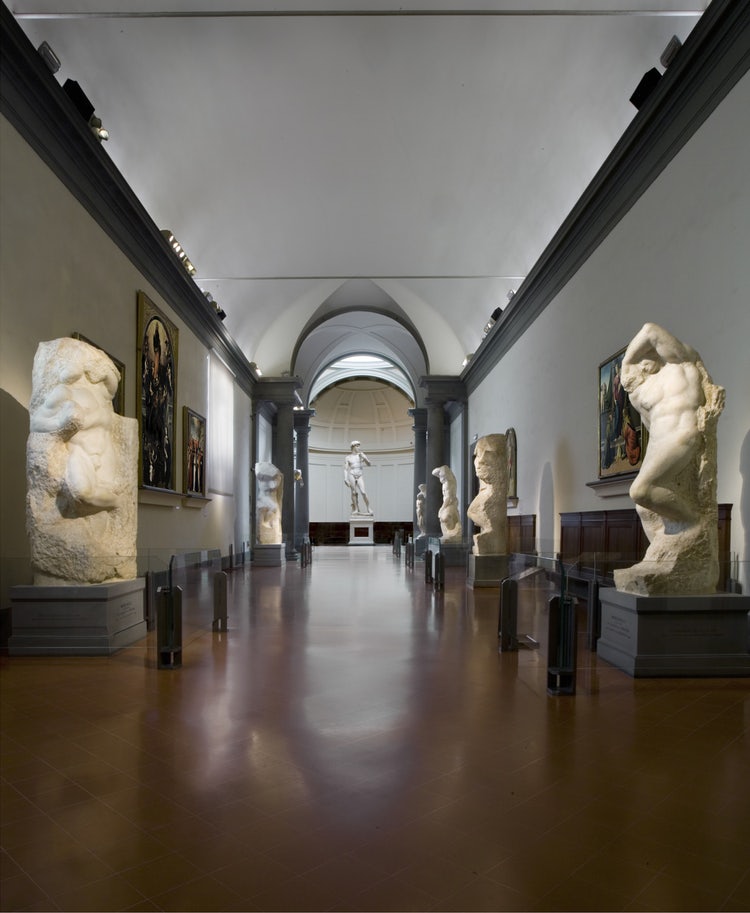The Gallery of the Academy of Florence is an art museum in Italy, best known for the sculpture "David" by Michelangelo, exhibited in the "Hall of Prisoners". Here are collected other famous statues of the master, as well as a large collection of works by other sculptors and paintings by Italian painters from 1300 to 1600. This is one of the largest Florentine expositions. During 2016, 1,461,185 excursions visited it, making the gallery second in terms of attendance at the Florence art museum after the Uffizi.
Florence Academy Gallery Address: 58–60 via Ricasoli. The building is adjacent to the educational institution of the Academy of Fine Arts, but these are different institutions, despite their common name.
Story
The first European Academy of Art and Drawing was founded in Florence on January 13, 1563 by Cosimo I de Medici with the assistance of his court architect Giorgio Vasari, as well as painter Agnolo Bronzino, sculptor and architect Bartolomeo Ammanati. The institution was originally called the "Academy and the company of art of drawing" and was not only an educational institution, but also a kind of guild for all working artists proud. A group of students in charge of the institution's activities and training was organized, which included: Michelangelo Buonarroti, Lazzaro Donati, Francesco da Sangallo, Agnolo Bronzino, Benvenuto Cellini, Giorgio Vasari, Giovanni Angelo Montorsoli, Bartolomeo Ammannati and Giambolonia. The initial location of the Academy is the basilica of the monastery of Santissima Annunziata.

Another great prince of Tuscany, Pietro Leopoldo, united in 1784 all the drawing schools in one institution in Florence, the Academy of Fine Arts. A gallery of paintings and sculptures, a department of academics and an educational institution were placed in a former monastery on Via Ricasoli, in the rooms where the masterpieces remain today. The Academy also included artistic restoration and the Florentine Musical Institute, which since 1849 was removed from the Academy and formed as the Conservatory of Florence.
In 1873, the institution was divided into two separate centers: a training and academic college, called the Academy of Drawing Arts, and a gallery, where the works of great masters are presented for viewing.
Colossus Hall
Acquaintance with the exposition of the Academy Gallery in Florence begins in the Colossus Hall, the name of which remains after the models of huge statues of the Dioscuros from the Monte Cavallo square, shown here in the 19th century. Currently, the central space of the room is occupied by a plaster model made by Dzhamboloniya for his stunning marble sculpture "The Abduction of the Sabine Women" (1583).

On the four walls of the hall there are a large number of wood panels with tempera paintings by prominent masters of the 15th - early 16th centuries, such as Perugino, Filippino Lippi, Pontormo, Domenico Ghirlandaio, Bronzino. Two exhibits of the most important works of the exhibition are located near the entrance, on the right. The rectangular wood panel of 1450, 88.5x303 cm in size, skillfully painted with tempera, represents the front of the wedding chest (Cassone Adimari), once owned by the Adimari family. The picturesque genre scene reproduces the wedding holiday in Florence of the Renaissance with the image of streets, monuments (the Baptistery on the left), precious brocade garments testifying to the wealth and customs of noble families of that period.
To the left of Cassone Adimari is the second priceless treasure of the hall - “Madonna of the Sea”, created by Sandro Botticelli. The work owes its name to the seascape, which is dimly visible in the background. The charm of this work lies in the gold elements that emphasize the dark blue color, as well as in the symbolism that contains the details of the picture. A pomegranate in the hand of a baby Jesus indicates the passion of Christ. The star sparkling at the left breast of the Madonna is called “Stella Maris”, which translates as “Star of the sea”. In the transcription of the Hebrew name Miriam (Maria), there is also a consonance with the Italian word mare (sea).
Musical Instrument Exposition
One wing of the gallery of the Academy of Florence contains a collection of forty instruments belonging to the once great dukes of Florence and the Conservatory of Luigi Cherubini. Here you can see the first piano created by Bartolomeo Cristofori for the Medici, a collection of harpsichords, violins, cello and wind instruments. The pearl of the collection is the “Medici violin” made of red spruce and maple wood, created by Antonio Stradivari.
Prison room
The most famous section of the gallery, which shows the unfinished "Slaves" of Michelangelo, a series of statues located today in various European museums. It was an unfinished project of the tomb of Julius II. Copies of sculptures in the gallery of the Academy of Fine Arts of Florence are located along the corridor and form an increasing crescendo of emotions directed to the feet of the "David", exhibited on a special Tribune under the illumination of the glass dome.
Next to David is a series of paintings by Alessandro Allori, a delightful example of a peculiar vocabulary formed through plants. The key to reading the hidden message must be sought in the symbolism of flowers among the triumph of botanical species such as tulips, daisies, lilies, citrus fruits, forget-me-nots and others.
In the old hospital wing of the former monastery, now called Gipsoteca Bartolini, you can see the magnificent plaster works of Lorenzo Bartolini, one of the greatest sculptors and brilliant professors of the Academy of the XIX century.
"David"
For sculptors of all time, this masterpiece of the gallery of the Academy of Arts of Florence is considered the standard of its ideal composition, transfer of texture, proportions, emotional expressiveness. Michelangelo unsurpassedly displayed, in a seemingly relaxed pose of a young man, inner tension and concentration. His sling is thrown over his shoulder, a stone is in his hand, his eyes are fixed on the opponent and measures the distance. He is preparing to make his fateful throw at Goliath. Not a single sculpture was copied in such numbers as "David", for parks, gardens, squares, outstanding museums around the world. But only the original creates the impression of a frozen life in stone, the hidden energy in stillness, which the sculptors have always sought to convey at all times.

In 1466, a multi-ton marble block was delivered to Florence a hundred kilometers from the quarries of Carrara. The five-meter statue of David was to become the third large-sized sculpture of twelve depicting Old Testament characters commissioned by the guild of wool merchants. All twelve statues were supposed to be installed around the Cathedral of Santa Maria del Fiore. The sculptor Agostino, after him Rossellino, tried to start work. The first refused, barely proceeding to the bottom of the "David", the contract was broken with the other. The block remained in the open air, being destroyed, until 1501, until the curators of the cathedral signed a contract with the 26-year-old ambitious architect Michelangelo Buonarroti. A month later, the sculptor began work on which he worked for two years. In January 1504, during the final works, a group of leading artists from Florence visited the workshop to evaluate the work of Michelangelo. All members of the commission, among whom were da Vinci and Botticelli, were shocked by the perfection that appeared before them in the image of marble David. Impeccable forms, perfect execution and emotional state, incomprehensibly conveyed by the master, also amaze visitors to the gallery of the Academy in Florence today.
Hall of Gothic painting of the XIII-XIV centuries
The last section of the lower floor museum is dedicated to the Gothic works of Italy and Florence. The Academy Gallery presents a priceless collection of gold altar works, crucifixes, icons of Giotto and his followers such as Bernardo Duddy and Orkanya. Many works came here from Florentine churches and monasteries. After recent restorations, the vibrant colors of the panels will help you learn more about the features of clothing and hairstyles of Florentine residents of the Middle Ages and the early Renaissance.
Art of the end of the 14th century
After visiting the last hall, most visitors leave the museum. But there are still rooms on the top floor, which, of course, will be interesting. They are less crowded and are called Giovanni da Milano & Late 14th century (Giovanni da Milano and the end of the 14th century). Here you can find out how carefully and painstakingly the altars were created, starting with the choice of poplar from which the boards were then made, as well as the further preparation process before applying the painting layer with tempera. The video will introduce you to the amazing technique of egg tempera and show how the image layer by layer was created on a wooden altar, first carefully covered with gold leaf. The ancient method of painting with natural pigments mixed with egg yolk remains effective today. It is used in Florence in the art workshops of restorers.
Additional Information
The working hours of the gallery of the Academy of Florence are from 8:15 to 18:50. Mondays, New Year's, Christmas holidays and May Day are weekends for all museums in Florence, including the Academy gallery.
The cost of tickets, including a visit to the exposition of Musical Instruments, is 6.50 euros, and 4.50 euros (1 euro is about 75 rubles) will have to be paid extra if you want to see the Lorenzo Bartolini exhibition. A sculptor of beautiful nature. " There is a preferential price for tickets, but it is valid for citizens of Italy, as well as EU countries. Tickets can be ordered at the box office for the next day sightseeing or on the Internet. So you can avoid the tedious queue in one of the most visited museums in Florence. Please note that shooting with photo and video equipment is prohibited.
According to many sightseers, the Academy is undoubtedly becoming the most enjoyable place at the end of the day. The museum offers later hours to visit in the summer and then you can explore it, quietly reflecting on the value of art in the era of Michelangelo and skilled Florentine artisans, talented enlightened minds and creative patience.